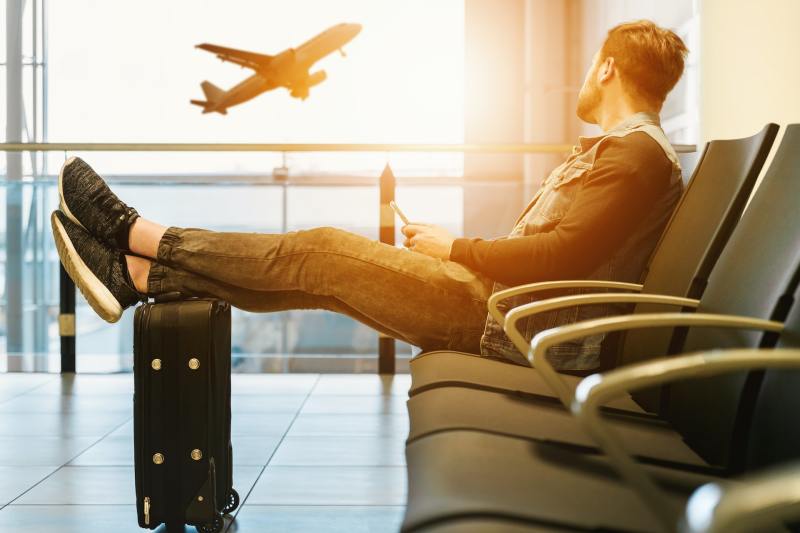While traveling by plane is convenient, it doesn’t come without its own challenges. I know from experience that economy seats on planes can leave you locked in place (literally) with little to no room to move around. Couple this with connecting or layover flights or long flights, and I’ve had extended periods of travel where I’ve hardly been able to move my legs at all! If you’ve noticed your feet swelling after flying — don’t panic yet.
Foot and leg swelling during travel is uncomfortable and annoying, yet quite common. But is it cause for concern or simply an annoyance? Understanding why swelling occurs during travel and what to do about it is essential to prevent circulation problems. Below, we’ll dive into what you need to know about dealing with your feet swelling after flying and tips to help you prevent this uncomfortable sensation next time you fly.
What causes swelling after travel?

Most times, airports can be hectic — which means you’re likely thinking more about checking your bags, finding your gate, and printing your boarding passes for your travel than your feet while trying to get to your plane. Once you’re finally aboard your flight and it has taken off, you’ll quickly realize there is no room to move around. The lack of movement when flying is the most common reason your feet, ankles, or legs may swell. By sitting for prolonged periods and having your feet on the floor, blood begins to pool in the legs, which causes this swelling (also known as edema). During travel, you might feel cramping or discomfort in your legs, but usually, you won’t notice the swelling until later or the day after flying.
According to the Mayo Clinic, the position of your legs while sitting on an airplane can also cause increased pressure in the veins in your legs. As pressure builds, especially on longer-duration flights, swelling can worsen as blood moves into the surrounding tissues. The longer you are sitting without movement, the more gravity will pull the fluid down to your ankles or feet. One study even found that nearly 97% of people who fly on flights longer than 7 hours experienced some form of edema in the feet, legs, or ankles.
Although longer flights are usually the culprit, even short flights, such as two or three-hour flights, can cause swelling in some people.
Other contributing factors

The most common reason for feet swelling after flying is simply the lack of movement. But this is not always the sole reason. Here are some other factors that may cause your feet to swell during a flight:
- Changes in exercise habits
- Changes in water intake
- Changes in food consumption
During a hectic travel day, you’re off of your everyday routine — which means changes in how you work out, how much water you drink, and what you eat. Perhaps you’re not drinking as much water as you would at home (or avoiding expensive airport bottled water) or consuming salty processed food at airport restaurants or food courts. Or maybe you’ve skipped your morning workout to catch your flight. All of these other contributing factors can cause or worsen swelling after flying as well.
Why you should care about swelling

Experiencing swelling in your ankles, feet, or legs after travel is usually just an annoyance and mostly harmless — yet that doesn’t mean you shouldn’t pay attention to it. While uncommon, some cases of foot or leg swelling from flying could be a sign of another medical condition known as Deep Vein Thrombosis (DVT). The lack of movement for extended periods and reduced blood flow in the veins can cause this condition to manifest.
Unlike harmless edema from long flights, a DVT often causes painful legs, redness around the ankle or foot, or skin that is warm to the touch. A DVT can also cause swelling in only one leg, whereas harmless flying edema is likely to cause swelling in both legs equally. Travel edema should resolve within a day or two at most. If you suspect your swelling may be a DVT, seek medical attention right away.
Travel tips for preventing feet from swelling after flying

Feet or leg swelling after flying is inconvenient, but it’s certainly not inevitable. You can implement several travel tips before, during, and after your flight to reduce the severity of your swelling. Take note for the next time you travel!
Hydration
Drinking plenty of water is one simple yet effective way to help you manage foot swelling. Swelling can cause your body to hold onto excessive fluids, which is worse when dehydrated. Drink plenty of water before, during, and after your flight to stay hydrated and prevent your body from holding onto more fluid than necessary.
Compression socks
Compression socks, often worn by healthcare workers, can also help manage swelling on long travel days. These socks (also called stockings) help improve blood flow in the lower extremities, thereby reducing edema.
Stretch legs whenever possible
Have time in between a layover? Move around and stretch your legs as much as possible between flights. If you only have one long flight, try to book an aisle seat, allowing you to get up and move around periodically. Standing or even walking to the bathroom throughout the flight can help move the blood in your legs.
What to do during the flight

You can take measures during the flight to help combat foot swelling. And most of them are fairly simple, and they are all extremely effective.
- Take off your shoes, especially if they are tight. Even taking them off for just a short time will help relieve some of the swelling.
- Don’t cross your legs. Crossing your legs while seated (and who can really do that in an airline seat anyway?) can restrict your blood flow and lead to swelling. Keeping your feet flat on the floor or using a footrest if one is available is the way to go.
- Move around the cabin. As long as it is safe to do so, don’t be afraid to get up and take a short walk. If you can’t get up, you can do some in-seat exercises like flexing your ankles, rotating your feet, and even just wiggling your toes to help your circulation.




